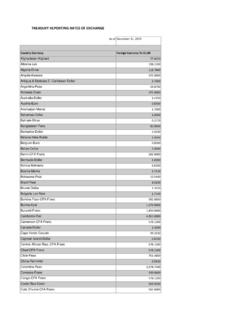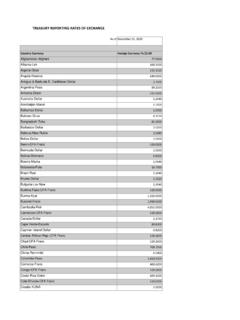Transcription of RESULTS-BASED MANAGEMENT - International Labour …
1 RESULTS-BASED MANAGEMENT HANDBOOKH armonizing RBM concepts and approaches for improved development results at country level October 2011 This handbook development exercise was spearheaded by the RESULTS-BASED MANAGEMENT (RBM) Task Team of the United Nations Development Group working group on programming issues. The team was co-chaired by United Nations Population Fund and the United Nations Children s Fund and included the RBM focal points: United Nations Development Programme (Abdul Hannan, Shane Sheils, Patrick Tiefenbacher), UNICEF (Paulette Nichols, Balaji), UNFPA (Farah Usmani) the Joint United Nations Programme on HIV/AIDS - UNAIDS (Dominique Mathiot), the United Nations Development Fund for Women ( ), the Food and Agriculture Organization of the United Nations (Clare Sycamore), the United Nations World Food Programme (Kofi Owusu-Teiku) and the United Nations System Staff College (Ritsu Nacken-Morino).
2 The team provided overall guidance, developed the scope and terms of reference for the exercise, made specific review comments, provided background documentation and references as well as drafted selected sections. The final unedited draft of the handbook was endorsed by the RBM Task Team members in October draft of the RBM Handbook was prepared by Francoise Coupal, President, Mosaic International , Canada through a consultancy supported by the United Nations Development Operations Coordination Office (DOCO). Support from DOCO (Eiko Narita, John Apruzzese) for the RBM handbook development exercise is draft handbook was reviewed by field colleagues from selected Resident Coordinator offices.
3 These include Albania, Bosnia and Herzegovina, cape verde , Lao People s Democratic Republic, Malawi, Pakistan, Papua New Guinea, Tanzania, Turkey, Uruguay and Viet Nam. These offices shared the handbook with RBM specialists in their United Nations Country Teams and provided comments from a United Nations Development Assistance Framework and Delivering as One perspective which helped focus the handbook on field issues and United Nations Evaluation Group (UNEG) provided detailed comments regarding RBM and evaluation linkages, including harmonization with UNEG norms and standards. The draft handbook has also been shared with members of the United Nations Strategic Planning Network.
4 Review and comments on the draft were also received from UNDAF Programming Network colleagues including the United Nations Educational, Scientific and Cultural Organization, the International Labour Organization and the World Health Organization which have been addressed in this January 2011 Office for the Coordination of Humanitarian Affairs and DOCO coordinated efforts to gather comments and input on the section on RBM in crisis and post-crisis settings through consultations with the UNDG Executive Committee on Humanitarian Assistance Working Group on Transitions. Thus, this handbook is also envisaged to facilitate harmonization of RBM concepts and approaches in crisis and post-crisis RBM concepts and approaches for improved development results at country level RESULTS-BASED MANAGEMENT HANDBOOKO ctober 2011 Endorsed by the UNDG RBM task Team and incorporating comments from UNDAF Programming Network review and UNDG meeting of January 2011 United Nations Development GroupiiCAP Consolidated Appeals ProcessCCA Common Country AssessmentCHAP Common Humanitarian Action PlanCPAP Country Programme Action PlanCPD Country Programme DocumentCSO Civil society organizationDAC Development Assistance Committee of the (OECD)
5 DAR Development assistance for refugeesDPKO Department of Peacekeeping OperationsECOSOC United Nations Economic and Social CouncilIMPP Integrated Mission Planning ProcessISF Integrated Strategic FrameworkJMAC Joint Mission Analysis CentreMDG Millennium Development GoalM&E Monitoring and evaluationMfDR Managing for development resultsNGO Non-governmental organizationPLA Participatory Learning and ActionOECD Organisation for Economic Co-operation and DevelopmentRRA Rapid rural appraisalRBM RESULTS-BASED managementRC Resident Coordinator (of the United Nations system)SWAp Sector-wide approachesTCPR Triennial comprehensive policy review of operational activities for developmentUNCT United Nations Country TeamUNDAF United Nations Development Assistance FrameworkUNDG United Nations Development GroupUNEG United Nations Evaluation GroupWGPI Working Group on Programming IssuesACRONYMSiiRESULTS- based MANAGEMENT HANDBOOKiiiTable of ContentsTABLE OF CONTENTSINTRODUCTION ivPART 1: OVERVIEW OF RBM What is RESULTS-BASED MANAGEMENT ?
6 Key RESULTS-BASED MANAGEMENT Principles: 3 Accountability 3 National Ownership of results 4 Inclusiveness (or Stakeholder Engagement) RESULTS-BASED MANAGEMENT and Managing for Development results Basic RESULTS-BASED MANAGEMENT Terminology 6 PART 2: RBM IN PLANNING What is a Result? Getting Started: How to Define results ? Formulating results The results Chain Developing the results Matrix 15 Outcomes and Outputs 16 RBM: One of the Five United Nations Programming Principles 17 Indicators, Baselines and Targets 19 Means of Verification 20 Assumptions and Risks 21 Role of Partners 22 Indicative Resources 22 PART 3: RBM IN MANAGING Managing for Outcomes Managing for UNDAF Outcomes 24 PART 4.
7 RBM IN MONITORING Tools for Monitoring Developing the Monitoring and Evaluation Plan Monitoring and Evaluation of the UNDAF as a System Measuring Progress in Policy Norms and Standards 32 PART 5: RBM IN EVALUATION RESULTS-BASED MANAGEMENT in Evaluation United Nations Evaluation Guidance Inter-Linkages and dependencies between Planning, Monitoring and Evaluation 37 PART 6: RBM IN REPORTING 39 PART 7: USING RBM FOR LEARNING, ADJUSTING & DECISION-MAKING 43 PART 8: RBM IN CRISIS AND POST-CRISIS SETTINGS 45 Concerns in Crisis and Post-Crisis Settings 46 ANNEXES 49 Annex 1: Examples of UNDAF results Matrices 50 Annex 2: Change Language 55 BIBLIOGRAPHY 56 FIGURES, BOXES AND TABLESF igures1.
8 T he RBM Life-Cycle Approach 22. Accountability 43. K ey Stages in Formulating results Statements 104. Elements of an Effective RESULTS-BASED Report 415. Use of results Information for Organizational Learning 44 Boxes1. Six Principles for United Nations Organizations to Contribute Effectively to RESULTS-BASED MANAGEMENT 52. Definition of Key United Nations Programming Terms 73. What does a Human-Rights- based Approach add to RBM? 184. What is Evaluation? 345. Assessing the use of an Evaluation 356. Understanding the Inter-Linkages and dependencies between Planning, Monitoring and Evaluation 37 Tables1. Changes reflected in results at different Levels 132.
9 T he results Chain 143. results Matrix with Outcome and Output Levels Option 1B 164. Indicators 195. Checklist for Validating Indicators 206. Risk Matrix 227. K ey Challenges and Strategies to Overcome them 248. M&E Calendar 329. Example of a RESULTS-BASED Report 42 RESULTS-BASED MANAGEMENT HANDBOOKivINTRODUCTIONIn the late 1990s, the United Nations initiated RESULTS-BASED MANAGEMENT (RBM) systems1 to improve the organization s2 effectiveness and accountability. A 2008 review of the status of RBM implementation in the United Nations system showed that different RBM defini-tions and terminology were in use among United Nations organizations. More importantly, these variations reflected a disparity in focus, understanding and perception of RBM within the differences made it difficult to communicate on RBM issues using a common language.
10 It is recognized that there is no single road map to RBM and that each organization must adapt RBM to its specificities and mandates in the context of national priorities. Yet, there are also a wide range of commonalities among United Nations organizations that constitute a basis for harmonizing implementation of RBM is particularly important in the context of United Nations reform with its emphasis on harmonized support to development activities at county level including joint initiatives/joint program-ming. In resolution 62/208 regarding the triennial comprehensive policy review (TCPR), the General Assembly stressed that, The purpose of reform is to make the United Nations development system more efficient and effective in its support to developing countries to achieve the interna-tionally agreed development goals, on the basis of their national development strate-gies, and stresses also that reform efforts should enhance organizational efficiency and achieve concrete development results .















